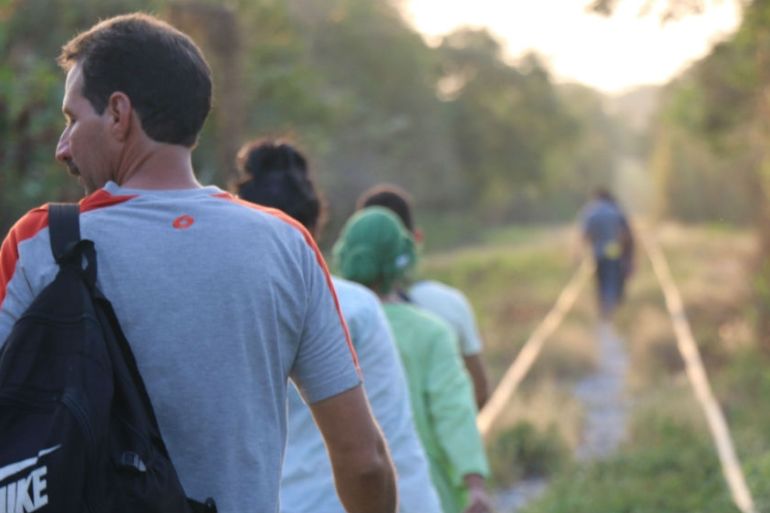From Cuba to the US, a perilous journey
Dozens of Cubans risk their lives daily, illegally crossing several countries to get to the US.

Over just the past few months, hundreds of Cubans have been crossing half way across the American continent in an attempt to arrive on US soil.
The majority fly to Ecuador, one of only two countries which, along with Guyana, doesn’t require Cubans to have an entry visa.
Keep reading
list of 4 itemsNigeria’s women drivers rally together to navigate male-dominated industry
‘I blame the government’: Poor Kenyans say no support amid record flooding
‘We need you’: Solomon Islands’ support for US agency’s return revealed
From there they cross eight countries in an exhausting journey which leaves them with few good memories.
During the three days that our Al Jazeera team documented their journey, we learned that the typical Cuban migrants have a different profile than what one might expect.
They are highly educated and they have money or relatives who finance the journey which makes them virtual cash machines for con men and assailants along the way.
Our team followed a group of five men and two women, some of whom had been travelling constantly for two and a half months.
![Angel Fernandez, a 25-year-old Cuban migrant in red chequered shirt, leads a group of seven others on their crossing of the Suchiate river along the Guatemala-Mexico border [Amparo Rodriguez/Al Jazeera]](/wp-content/uploads/2015/06/cc04b8d8a6be471483c3d7f0bfbe784f_18.jpeg)
Angel Fernandez, 25, worked in a mobile phone store in Cuba and earned the equivalent of $10 a month. He hadn’t spoken to his parents since he left Cuba, and they still don’t know that he is en route to the US.
Israel de la Rosa and his wife Joani sold their house to finance the journey. They left behind several children, the youngest of which is only nine. The couple crossed the jungle in Colombia, hardly eating or drinking for days.
In Colombia, they were assaulted 11 times, at 11 different police checkpoints. During one of these attacks, $1,500 hidden in the sole of one of their shoes, was stolen.
We learned little of the other four members of the group. It was difficult to talk, run and hide from immigration officials at the same time.
![Cuban migrants use back roads to avoid being caught by immigration officials or assaulted by criminals [Amparo Rodriguez/Al Jazeera]](/wp-content/uploads/2015/06/aaac86ec126a42ad832b40f21dc0e60a_18.jpeg)
The group crossed the Guatemala- Mexico border illegally via the river Suchiate, like thousands of immigrants each year. From there they started their pilgrimage, constantly getting on and off buses, trying not to draw too much attention to themselves.
Very often they had to get off the bus and walk around the immigration checkpoints, while trying to avoid the authorities and assailants. Bus drivers, aware that they have entered the country illegally, often tried to charge them five times the normal fare.
While on route, migrants are at the total mercy of robbers. They can´t ask for protection from the police, so they walk for miles to avoid the areas where it is more likely they will be assaulted.
![Cuban migrants hop on and off buses on their journey through Mexico. [Amparo Rodriguez/Al Jazeera]](/wp-content/uploads/2015/06/118c899f3c374e089b98772ad000b438_18.jpeg)
We walked along with them, often asking locals for information on where the assailants usually hide. When walking near immigration check points, we circled around them, running and ducking, so we wouldn´t be seen.
The seven Cubans we followed spent their first night in Mexico at the mercy of the elements, sleeping in a ditch by the side of the road. The next day, having barely slept, they continued to Arriaga, where the famous cargo train, known as La Bestia passes.
This train used to carry hundreds of Central American immigrants on its roof. But last summer, the Mexican government implemented an immigration plan that saw more and tougher controls over migrants crossing the border.
![Hundreds of people cross the border between Mexico and Guatemala over the Suchiate river every day. In the background is the bridge and legal pass that links both countries [Amparo Rodriguez/Al Jazeera]](/wp-content/uploads/2015/06/8ec6656f325d4e7ea03e2115b3cc7130_18.jpeg)
Migrants are no longer allowed to ride the train. Now, hundreds of them, including Cubans, follow the train’s route north hopping on and off dozens of buses for months.
On our third day accompanying the migrants, we separated for a few hours, and abruptly lost contact with the group. We knew they were trying to circle an immigration cheque point, in the border between the states of Chiapas and Oaxaca.
It was one of those hot spots, where migrants are often detained by officials, or are assaulted by robbers. We never saw them again, and repeated efforts to reach them by phone came to nothing.
![Israel de la Rosa and a group of Cuban migrants walk along the railway, hiding from migration authorities [Amparo Rodriguez/Al Jazeera]](/wp-content/uploads/2015/06/2d99e42eac7944a8bb76c361ec321f25_18.jpeg)
Weeks later, we received a phone call. They had been taken by immigration authorities, were in custody for nearly a month, and were finally given a visa to cross Mexico.
They are now safe, in the US.